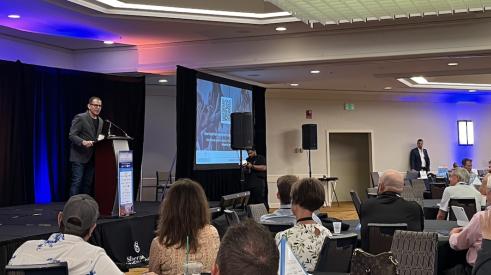I sat on a panel recently for NARI Greater Chicagoland and unsurprisingly, the topics of hiring, company culture, and work-life balance were on everyone’s minds. One idea that came up, to mixed reactions, was the four-day work week.
The concept may seem unrealistic in remodeling, but that’s far from the truth. In fact, for some remodelers in the room, it’s how they do business.
Don Van Cura of Don Van Cura Construction in Chicago made the change almost three years ago. David Callahan of Callahan & Peters and Ron Cowgill of D/R Services Unlimited, both in Glenview, Ill., have been offering shortened work weeks for more than 20 years; though, Callahan operates on a four-and-a-half-day work week.
There’s plenty of precedent for a four-day work week outside the United States.
In June, the United Kingdom kicked off one of the largest four-day work week trial runs—orchestrated by 4 Day Week Global, a not-for-profit that claims that 78% of employees with four-day weeks are happier and less stressed.
RELATED: How We Nurture Trade Partner Relationships
Benefits for Remodeling
While 4 Day Week Global’s model focuses on 32-hour weeks, the Chicago area business owners run on four 10-hour days. Each expressed finding few (if any) negatives with the revised schedule.
“We said we’d try it for six months, and if it’s a problem, we’ll go back,” shared Ron Cowgill. “There really weren’t any downsides, and that’s why we never stopped it.”
Each remodeler expressed a similar experience; it began as a trial but became an unexpected solution to several challenges: hiring, limited time, and work-life balance. Yes, employees and the owners must work longer days (typically 7 am until 5:30 pm, Monday through Thursday), but those adjusted times actually help team members beat rush hour, and they don’t have to commute five days a week (especially helpful with today’s gas prices).
Teams also tear down and clean up jobsites only four times a week. And even if crews have to come in on Friday, they’re getting paid overtime to do it and still have their weekend. While Cowgill admits that longer days could be difficult for some older employees, his team has still rarely called a day short.
As owner, Cowgill finds that those empty Fridays help him catch up on his backlog of administrative work, such as writing estimates and scheduling.
Client Communication
One concern raised during the panel was how the homeowner might respond to the four-day week. Remodeler Don Van Cura was quick to challenge the misconception.
Clients enjoy having their kitchens back on Fridays, Van Cura says. And while Van Cura’s focus is on happy clients, a greater focus for him is happy employees.
“I really think it’s more our mental problem than it is to clients because we’ve noticed no change,” Van Cura shared, adding that the untraditional schedule conversation is one of the first had with potential clients.
RELATED: Are Your People Burned Out?
Getting the Schedule Right
Still, Fridays remain a working day for most everyone else, so Cowgill and Callahan request their employees remain on call for emergencies.
“Even if I have schedules to work on Friday afternoon, I know I can do it outside the normal structure: I can kick back on my deck, and it’s the same thing with our designer,” Callahan told me. “She has a toddler and she can go home.”
Cowgill adds it’s “clearly an advantage” because two of his latest hires applied specifically for the shortened week.
Clearly there are no rules for a four-day work week. From shortened hours to stretched days, the model varies, tweaked to fit the needs of an owner and their team. As remodelers seek solutions to longstanding challenges, the concept may not be as unreasonable as it seems.
Comments (1)
Add new comment
Related Stories
Brian Gottlieb Receives Remodeling Mastery Award
Presented by industry icon, Mark Richardson, the award celebrated Gottlieb’s extraordinary impact on remodeling
What's Beyond the Hammer?
Working with Brian Gottlieb on the book Beyond the Hammer provided a masterclass on how to build an aligned team
Real AI Applications For Remodelers
Tech-forward remodeler Michael Anschel shares how he uses artificial intelligence in his business.
How to Eliminate Boring, Languishing Meetings
Leff Design Build ensures maximum productivity and efficiency through these straightforward methods
5 Counterintuitive Strategies to Improve Your Business
Follow these strategies to inspire employees, instill trust, and beat the competition
Couple Act As Much More Than General Contractors
How LBR Partners uplifts and educates their Spanish-speaking trade partners
Artificial Intelligence Meets Design
An architect looks at the pitfalls of using technology to take over human design tasks
How to Correctly Hire for Business Growth
Refloor CEO Brian Elias shares exactly how his company hires the correct people for the correct seats
Managing Business Risk to Embrace Risk
As remodelers, our product is risk. Yet within our businesses, we fear risk. Just like with your projects, if you plan accordingly, your risk comes with reward
What the Most Successful Remodelers are Doing Right Now
Industry advisor Mark Richardson shares the answers to his three most asked questions: What's the remodeling market like? What are other remodelers doing? How do I measure up?














4 day work week
Submitted by Dennis D. Gehm… (not verified) on Fri, 08/05/2022 - 11:55
4 day work week
We made the move to 4- ten hour work days for our production staff in 2006. They work 7am - 5pm and get paid for lunch. Clients appreciate an extra day down time. If we tried to go back to working 5 days we would have a mutiny on our hands. It's help to attract some good team members